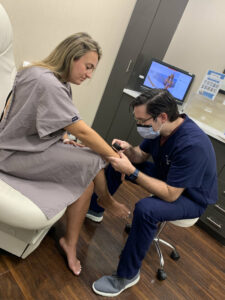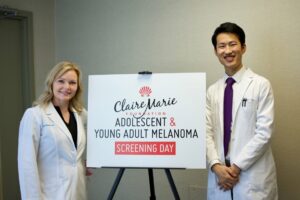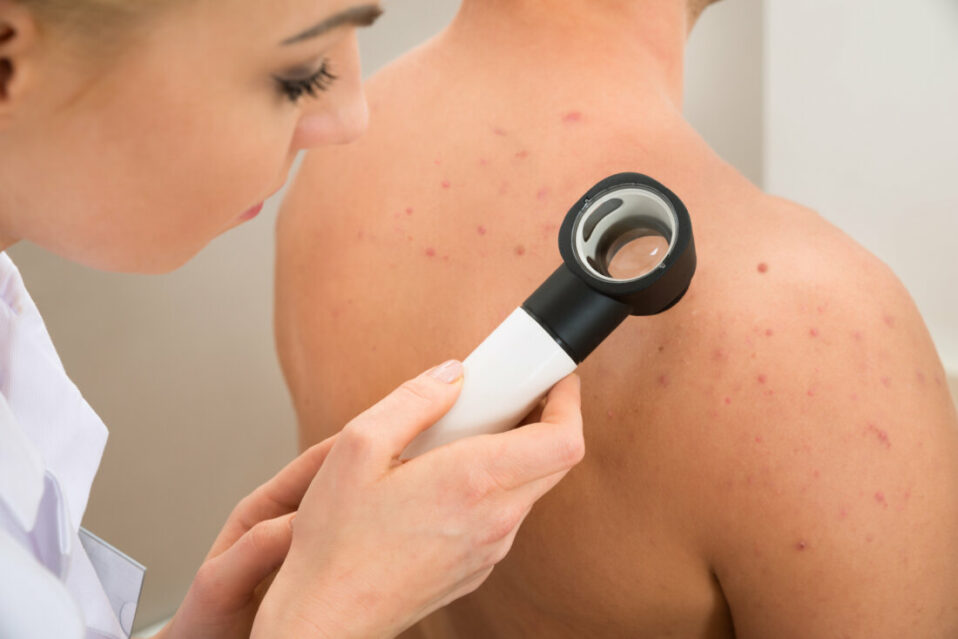We cannot say it enough! Make sure you are screened annually for melanoma and other skin cancers. It is essential to nip melanoma in the bud, halting its ability to move through your body and threaten your life. But who does the screening and how they screen can make all the difference. Here’s some tips to keep in mind!
Rule #1: Skip Your Primary Care Physician
Surprise! Pediatricians and General Practitioners do not routinely study dermatology in their medical preparation. That means they are not trained to detect skin cancer and melanoma at its earliest point of origin. The result; melanoma is often overlooked or misdiagnosed at the earliest stage when it is most highly treatable – especially in young people.
Rule #2: Find the Right Dermatologist
Before you book your neighbor’s favorite dermatologist, listen to this: not all dermatologists are equally trained nor have equal focus. Some specialize more in the aesthetic and cosmetic care of the skin. Others offer greater attention to the disease aspects of the skin. Then there are those who are equally balanced in both specialties. Do your homework before making an appointment. Sometimes you can get faster access by booking a screening with a Dermatological Physicians Assistant who has been trained specifically in dermoscopy to screen for melanoma. It’s all a matter of a dermatologists training, focus and expertise – and your ability to find the right person for you.
Rule #3: Advocate For Yourself!
Ask a few questions and make sure you are scheduling an appointment with a dermatologist who meets the Gold Standard of skin screening. This is no time to be shy! You should ask about their screening procedures and expect the following:
- The dermatologist will put you into a gown and do a full body check for moles and any lesions. That includes the feet, nails, head and genital areas. If a dermatologist suggests you don’t need a full body screening because you are “too young for melanoma”- find a new dermatologist
- Make sure the dermatologist uses dermoscopy. It is a screening technique that uses skin surface microscopy. It can also be called epiluminoscopy and epiluminescent microscopy. It allows the dermatologist to look into the layers, color patterns and changes deep within the mole, rather than just glancing at the surface. If a dermatologist wants to evaluate your moles with only their naked eye rather than use a dermatoscope – find a new dermatologist.
Rule #4: What If Something Is Found On My Skin?
Finding an atypical or precancerous mole doesn’t mean you have melanoma. But, it does mean something is changing on a cellular level. Since melanoma in adolescents and young adults is more aggressive and more invasive than in the older adult population – it should always be considered a victory to have an atypical mole removed and evaluated before it can evolve further. Remember: Remove the mole – Remove the risk.
- If a mole is found to be questionable, the dermatologist will determine if it should be removed for biopsy or if it should be watched. The appropriate time period for “watching” is three months. You should also keep a close eye on the mole in question and look for any other changes in your skin. Don’t hesitate to call if something evolves and changes before the scheduled follow-up appointment. And keep that appointment!
- Many dermatologists will photograph moles they want to keep an eye on to best detect any change. Still others may recommend “mole-mapping” technology in families at high risk for the disease. This involves full body photography.
So in answer to your question – who do I call? Here’s a few names for those in the Mid-Atlantic area and South Carolina.
 Listed below are the amazing ‘Gold Standard” dermatologists who dedicate their time and expertise to the Claire Marie Free Screening Program and meet the highest standards of care. All are listed in alphabetical order in the two cities we serve as of Fall 2022. Many are part of the renown teams at Johns Hopkins Dermatology, Simmons-O’Brien & Orlinsky, Belcara Health, Germain Dermatology, Maryland Dermatology, Skin & Vein, SCSPhysicians, Mercy Medical Center or University of Maryland Upper Chesapeake Hospital. Others are in Private Practice, and extremely attentive to their patient’s care. We are honored, privileged and so very grateful to have them join us in our mission to save young lives.
Listed below are the amazing ‘Gold Standard” dermatologists who dedicate their time and expertise to the Claire Marie Free Screening Program and meet the highest standards of care. All are listed in alphabetical order in the two cities we serve as of Fall 2022. Many are part of the renown teams at Johns Hopkins Dermatology, Simmons-O’Brien & Orlinsky, Belcara Health, Germain Dermatology, Maryland Dermatology, Skin & Vein, SCSPhysicians, Mercy Medical Center or University of Maryland Upper Chesapeake Hospital. Others are in Private Practice, and extremely attentive to their patient’s care. We are honored, privileged and so very grateful to have them join us in our mission to save young lives.
Baltimore, Maryland
- Dr. Melanie Adams, M.D
- Dr. Karen Beasley, M.D., F.A.A.D
- Dr. Nicola Bravo, M.D.
- Dr. Sarah Cannon, M.D.
- Dr. Bernard Cohen, M.D.
- Dr. Sherry Cohen, M.D.
- Dr. Jennifer Cooper, M.D.
- Dr. Meg Gerstenblith, M.D.
- Dr. Anna Grossberg, M.D.
- Dr. Christian Halvorsen, M.D.
- Dr. Sarah Hsu, M.D.
- Dr. Dennis Kurgansky, M.D.
- Dr. Onah Lauring, M.D.
- Dr. Mark Lowitt, M.D.
- Dr. Vadim Gushchin, M.D.
- Dr. Stanley Miller, M.D.
- Dr. Diane Orlinsky, M.D. F.A.A.D
- Dr. Rachel Schleicher, M.D.
- Dr. Amie Sessa, M.D.
- Dr. Eva Simmons – O’Brien, M.D., F.A.A.D
- Dr. Saif Syed, M.D.
- Dr. Zain Syed, M.D.
- Dr. Samantha Vincent, M.D.
- Dr. Margaret Weiss, M.D., F.A.A.D.
- Dr. Robert Weiss, M.D., F.A.A.D
- Dr. Sean Wu, M.D.
Charleston, S.C.
Germain Dermatology
- Dr. Marguerite Germain, M.D.
- Dr.Joshua Black, M.D.
- Louisa Floyd, PA-C
- Dr. Emily Kmetz, M.D.
- Lainey O’Donnell, PA-C



Post a comment